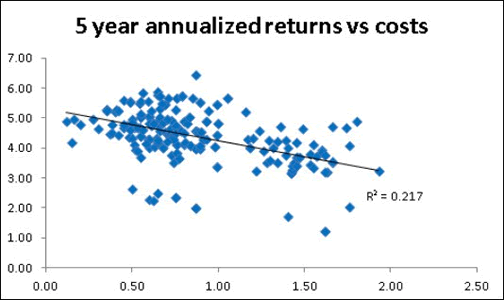Due to a lack of tax-deferred space, my current tax bracket, and the current interest rate spread over US Treasury bonds, I started investing part of my portfolio in Vanguard’s tax-exempt municipal bond funds. As a result, I try to read every single muni bond article that Vanguard puts out. In this month’s blog post Municipal debt, Detroit, and diversification, one of the topics covered was the importance of minimizing fund fees.
Research shows that lower-cost mutual funds have tended to perform better than higher-cost funds over time. So instead of worrying about things we can’t control (e.g., how a judge in a municipal bankruptcy is going to decide a case), we should focus on controlling the one variable that we can, which is cost.
The article included the chart below, which plots the net fund expense ratios of municipal bond funds against their 5-year annualized returns.

Source: Vanguard Blog, Morningstar
The relationship is clear: Lower expense ratios are positively correlated with higher returns. Again, as Chris Alwine has stated, “Cost is a big driver of return in fixed income products in particular, and [you should] understand the costs that you’re paying to invest in a specific mutual fund.”
The trendline shows a pretty direct relationship – for every 1% increase in expense ratio, I see roughly a 1% decrease in annual return. Mathematically, this is what you would expect on average. Low costs increase my odds of a higher return. However, remember that even though these are Vanguard funds, they are actively-managed and don’t just passively follow an index. So I am still hoping that Vanguard’s managers to show some degree of bond-picking skill.
At the same time, lower expense ratios means that the managers don’t have to do anything special to deliver the same tax-exempt yield. If two separate mutual funds owned the exact same bonds but the expense ratio on Fund B is 0.50% (50 basis points) higher than Fund A, then the net yield to the investor is 50 basis points lower with Fund B. So if Fund B doesn’t want to settle for that lower return, they have to go out and find different bonds that will perform better. Often this means looking for higher rates via higher interest rate risk (longer maturity) or higher credit risk (lower credit quality – see Puerto Rico exposure). Vanguard doesn’t have to take these extra risks. Indeed, Vanguard muni funds are well-known for maintaining a relatively high credit quality and shorter maturities.
So watch out for those costs. In addition to Vanguard, there are some other funds out there with reasonably low costs.
 The Best Credit Card Bonus Offers – 2025
The Best Credit Card Bonus Offers – 2025 Big List of Free Stocks from Brokerage Apps
Big List of Free Stocks from Brokerage Apps Best Interest Rates on Cash - 2025
Best Interest Rates on Cash - 2025 Free Credit Scores x 3 + Free Credit Monitoring
Free Credit Scores x 3 + Free Credit Monitoring Best No Fee 0% APR Balance Transfer Offers
Best No Fee 0% APR Balance Transfer Offers Little-Known Cellular Data Plans That Can Save Big Money
Little-Known Cellular Data Plans That Can Save Big Money How To Haggle Your Cable or Direct TV Bill
How To Haggle Your Cable or Direct TV Bill Big List of Free Consumer Data Reports (Credit, Rent, Work)
Big List of Free Consumer Data Reports (Credit, Rent, Work)
I haven’t invested in munis. Do you invest in a state-specific fund or a broader muni-bond fund with Vanguard? I also wonder if you have looked at the differences in tax implications of investing in a bond fund vs buying individual muni bonds.
I don’t invest in a state-specific fund, only national funds via Vanguard. If I lived in a state with high taxes AND where I could get low-cost access AND where the effective yield was high enough, I would considering put some but not all of my money in a state-specific fund (such as NY and CA).
I don’t have the size of portfolio needed where I believe I could get both enough diversification and benefit from individual bond purchases. It’s not like buying Treasuries where all of them have the same credit quality.
I am facing a similar situation. Trying to decide to fill up Ibonds or just go with munis. Did you purchase your yearly allotment of Ibonds first or are you not considering them this year?
I bought my max of I bonds this year, yes.
I owned the close end fund of muni by Blackrock (myi). It was a tax nightmare because the dividends are apparently taxed per scottrade, and turbotax could never figure out what state the dividends were from (i put nj)
Tl;dr buy muni funds in tax advantaged acts imo
Great – I’ll look forward to this quagmire this year. I invested in a NY CEF (NRK) and also have Scottrade – we’ll see what the tax forms look like.